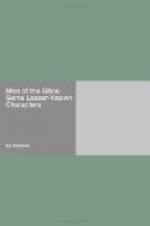“Like some tall palm, the graceful fabric grew,”
until it stood complete on Mount Moriah, an inspiration to the people, a continual benediction to the nation, and the envy of many a covetous conqueror.
The name of one man only has been handed down the ages as having specially signalised himself in the decoration of the temple. Solomon must procure the best of human talent and genius for the perfection of the work he meditated. Therefore he not only made a treaty with Hiram, King of Tyre, for supplies of material, but of workmen, and chief of these, one whose artistic productions were to be the best adornments of the House of God for succeeding centuries. He was a tried veteran in decorative work, an expert in almost every kind of art, and fit to be placed in the position of chief superintendent of so superb a building. The King of Tyre sent to Solomon a testimony which was eloquent in his praise: “I have sent a cunning man endued with understanding . . . . the son of a woman of the daughters of Dan, his father was a man of Tyre, skilful to work in gold, and in silver, in brass, in iron, in stone, and in timber, in purple, in blue, and in fine linen, and in crimson; also to grave any manner of graving, and to find out every device” (2 Chron. ii. 13, i4). Another record says: “He was filled with wisdom, and understanding, and cunning to work all works in brass” (1 Kings vii. 14).
It is a significant fact in the history that Hiram, this expert artificer, bearing the same name as his king, should have had an Israelitish mother, and a Gentile father who had also been a worker in metal. Thus he got his artistic taste and training from the father, his religious knowledge and sympathy from the mother. Religious feeling and sympathy he certainly had, as his magnificent work in the temple fully demonstrated.
Hiram constructed of bright, burnished brass, an immense laver, called “a molten sea,” to be used for the ablutions of the priests. It was capable of containing from fifteen to twenty thousand gallons of water, and the ornamentation was elaborate exceedingly. Under the brim were two rows of balls or bosses, encircling the laver. Twelve oxen, three looking in four different directions, supported it, and the brim was wrought like the brim of a cup with flowers of lilies. Beyond this, there were ten lavers, smaller in size, for the washing of such things as were offered in sacrifice. These were carefully decorated with lions, oxen, and cherubim on the borders of the ledges. They stood upon bases, measuring 6 feet by 4 1/2 feet, ornamented carefully on each side with garlands hanging in festoons, literally, “garlands, pensile work.” Each base had brasen wheels attached, with brasen axletrees, and brackets which stretched from the four upper corners of the bases to the outward rim of the laver. All the furnishings were also made by Hiram, such as pots, basons, shovels; probably also the golden




